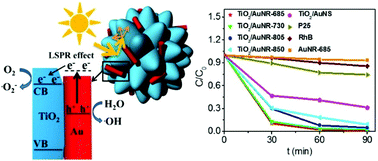Spiky TiO2/Au nanorod plasmonic photocatalysts with enhanced visible-light photocatalytic activity†
Abstract
A facile approach for the preparation of spiky TiO2/Au nanorod (NR) plasmonic photocatalysts has been demonstrated, which is through in situ nucleation and growth of spiky TiO2 onto AuNRs. Different aspect ratios of AuNRs in 2.5, 2.7, 4.1 and 4.5 have been applied to prepare spiky TiO2/AuNR nanohybrids to achieve tunable and broad localized surface plasmon resonance (LSPR) bands. All spiky TiO2/AuNR nanohybrids exhibit enhanced light harvesting by extending visible light absorption range by both transverse and longitudinal LSPR bands and decreasing light reflectance by their unique spiky structures. Compared to the bare AuNRs, commercial TiO2 (P25) and spiky TiO2/Au nanosphere photocatalysts, the spiky TiO2/AuNR photocatalysts exhibit significantly enhanced visible light photocatalytic activity in Rhodamine B (RhB) degradation due to their simultaneous enhancement in the light harvesting, charge utilization efficiency, and substrate accessibility. In particular, the spiky TiO2/AuNR-685 photocatalysts show the best photocatalytic activity with ∼98.9% of the RhB degraded within 90 min under the irradiation of 420–780 nm, which could be ascribed to the most extended visible light absorption range and sufficient photon energy of TiO2/AuNR-685 photocatalysts within this irradiation region. The bio-inspired nanostructure, as well as the facile and scalable fabrication approach, will open a new avenue for the rational design and preparation of high-performance photocatalysts for pollutant removal and water splitting.



 Please wait while we load your content...
Please wait while we load your content...